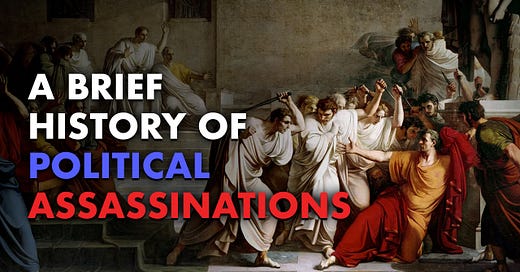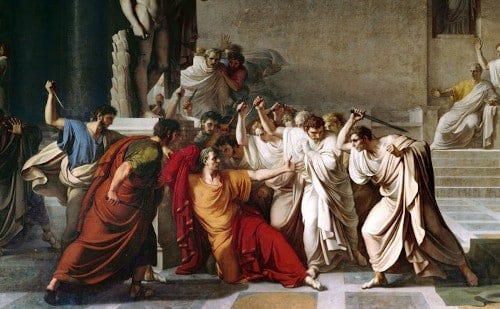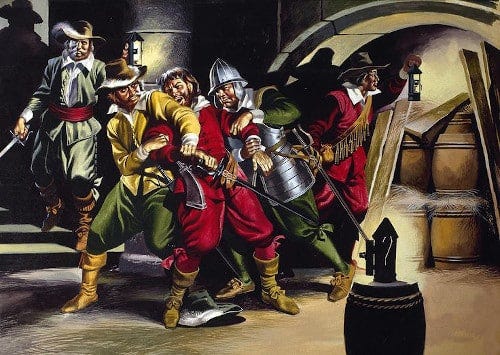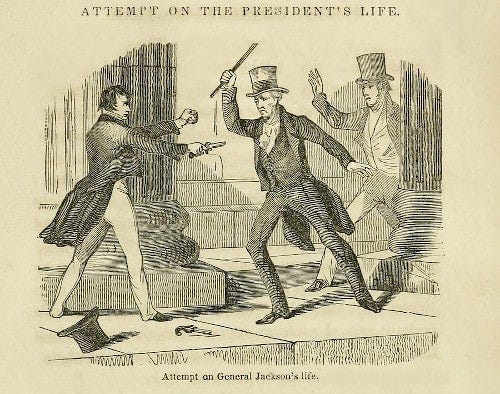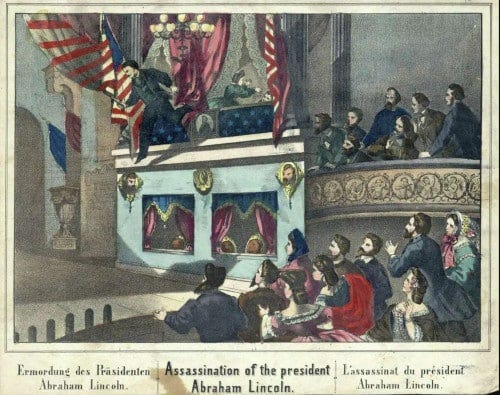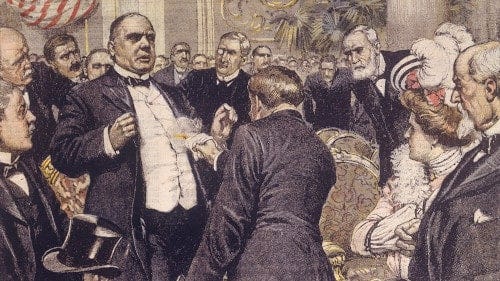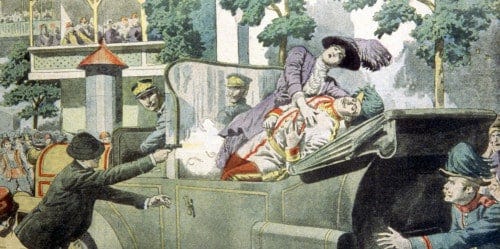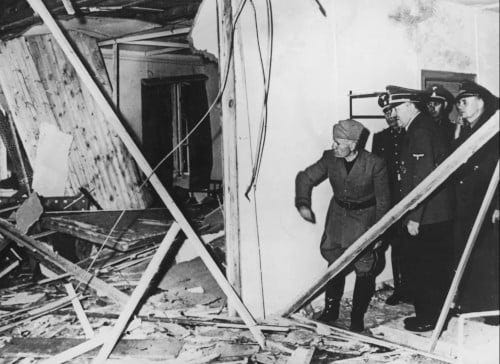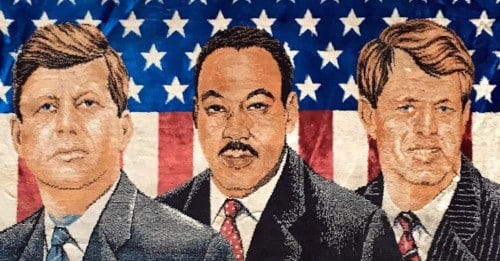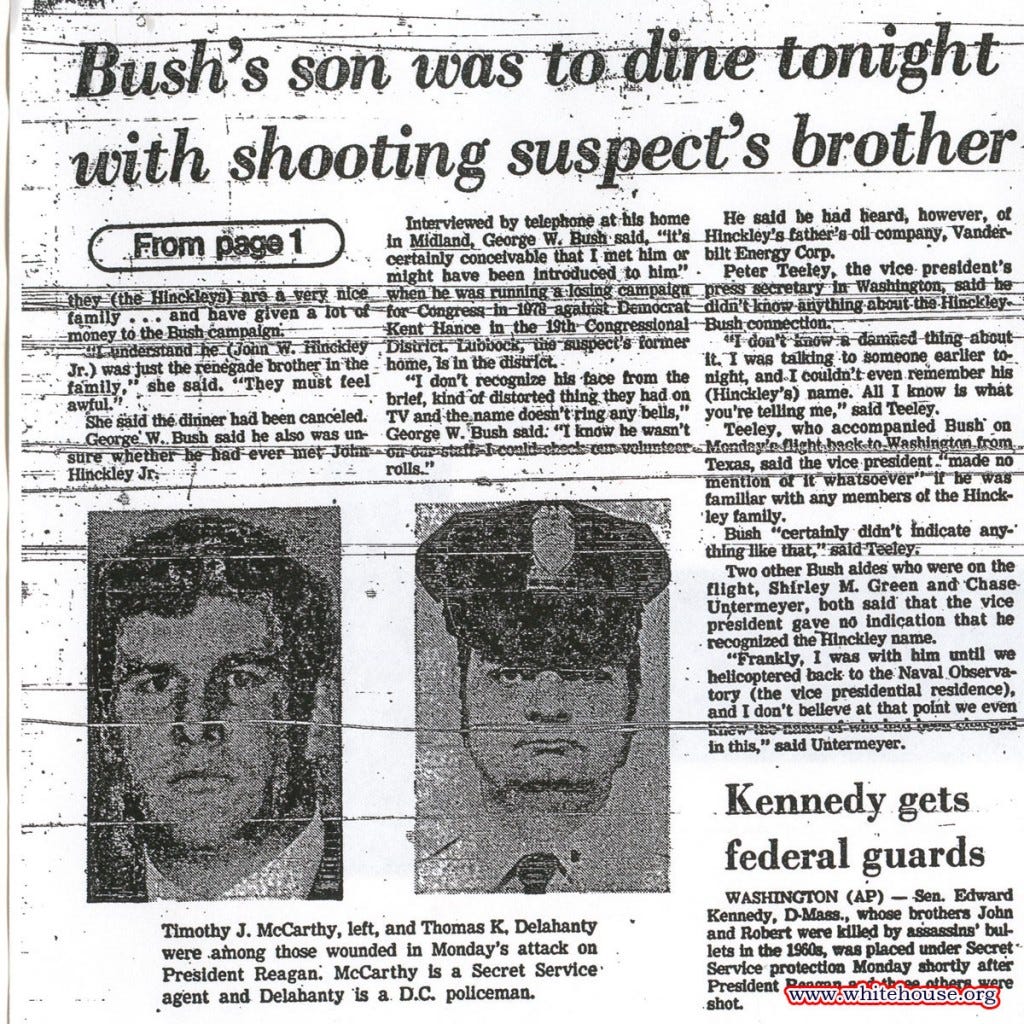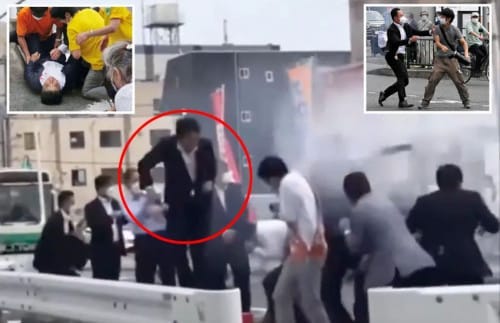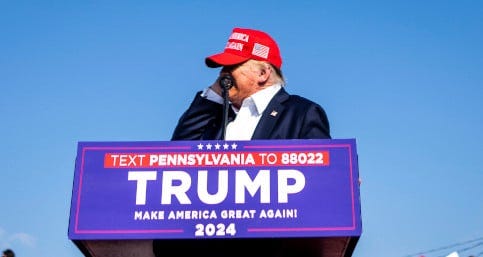by James Corbett
corbettreport.com
July 21, 2024
For as long as there have been "rulers," there have been political assassinations. It isn't hard to see why that's the case. After all, as long as people believe in The Most Dangerous Superstition—namely, that some have the right to rule over others—then there will be those willing to kill for that power.
So, apropos of nothing at all, let's look at some of the famous political assassinations (and attempted assassinations) in history, what they accomplished, and how they were perpetrated.
JULIUS CAESAR (SUCCESSFUL)
The assassination of Julius Caesar is the most famous political assassination in history, and it isn't hard to see why. The story of his downfall is replete with intrigue, betrayal, ambition, power, and empire. That story has introduced phrases to the vernacular that we still recognize today—"Et tu, Brute?" and "Beware the ides of March"—and has provided fodder for historians, artists and writers for thousands of years.
Yes, from Shakespeare to Star Wars, the tale of the fall of the Roman Republic still captivates us to the present day. You know: Caesar crossing the Rubicon, Caesar wearing red boots, Caesar becoming dictator-for-life, Caesar playing a game of yoinky-yeety with a diadem after the annual running-through-the-streets-naked-striking-everyone-you-meet-with-shaggy-thongs festival. That whole story.
The action culminated on the fateful ides of March in 44 B.C., when Caesar was set upon by dozens of conspirators as he was preparing to convene a Senate meeting. Many historians have described the scene, but perhaps none so memorably as Suetonius:
As he took his seat, the conspirators gathered about him as if to pay their respects, and straightway Tillius Cimber, who had assumed the lead, came nearer as though to ask something; and when Caesar with a gesture put him off to another time, Cimber caught his toga by both shoulders; then as Caesar cried, "Why, this is violence!" one of the Cascas stabbed him from one side just below the throat. Caesar caught Casca's arm and ran it through with his stylus, but as he tried to leap to his feet, he was stopped by another wound. When he saw that he was beset on every side by drawn daggers, he muffled his head in his robe, and at the same time drew down its lap to his feet with his left hand, in order to fall more decently, with the lower part of his body also covered. And in this wise he was stabbed with three and twenty wounds, uttering not a word, but merely a groan at the first stroke, though some have written that when Marcus Brutus rushed at him, he said in Greek, "You too, my child?" All the conspirators made off, and he lay there lifeless for some time, and finally three common slaves put him on a litter and carried him home, with one arm hanging down. And of so many wounds none turned out to be mortal, in the opinion of the physician Antistius, except the second one in the breast.
When you drill down on the details of Caesar's assassination and its aftermath, it's interesting to note that it follows the exact opposite of the narrative that is pushed by authorities in the wake of every political assassination these days.
There was no "lone nut" assassin to blame the incident on.
The government did not engage in a sloppy cover-up of the crime.
There was no gaslighting of the citizenry about what had taken place.
Indeed, rather than cover up their conspiracy, the gaggle of Senators who conspired to murder Caesar openly proclaimed it. After the killing, Brutus and his fellow conspirators marched through the streets, brandishing their blood-stained daggers and announcing, "People of Rome, we are once again free!"
The joyous celebration did not last long, however. The Roman Republic immediately descended into a bloody, years-long civil war followed by a bloody, years-long power struggle. In the end, Gaius Octavius—Caesar's adopted son and appointed successor—emerged victorious, bearing a new name and a new title: Augustus Caesar, founder of the Roman Empire.
There's a lesson in there somewhere. I wonder if we'll ever learn it.
KING JAMES I (UNSUCCESSFUL)
If you're not English, then you probably know Guy Fawkes as that guy from V for Vendetta or that face on the mask that members of the online hacker group Anonymous like to don in their promotional videos.
If you are English, then you probably know Guy Fawkes as that crazed Roman Catholic who tried to blow up King James during the State Opening of Parliament because . . . well, because he was a crazed Roman Catholic. The history books record that the scheme—known to history as "the gunpowder plot" and commemorated each November 5th with fireworks and bonfires—was a conspiracy that involved the principal Jesuit of England, Henry Garnet, and a team of crazed provincial Catholics. King James I used the revelation of this conspiracy as an excuse to implement a crackdown on Catholics throughout his kingdom.
True, it was a conspiracy . . . just not the type of conspiracy the history books record it as. In reality, it was a false flag operation, wherein forces from the King's court set up Guy Fawkes and his collaborators before swooping in at the last moment, catching Fawkes in the act, and thereby justifying King James' long-desired clampdown on Catholics. As Hugh Ross Williamson outlined in his 1952 treatise, The Gunpowder Plot, the elaborate plan for this false flag involved spies and subterfuge, torture testimony, forged confessions, and a band of patsies who would have been unable to fight their way out of a wet paper bag let alone blow up parliament if they weren't aided by higher powers along the way.
One wonders if the gunpowder plot is the template for the modern-day FBI and their habit of setting up and busting incompetent terror patsies.
ANDREW JACKSON (UNSUCCESSFUL)
In January 1835, US President Andrew Jackson was strolling through the Capitol Rotunda when a man emerged from the crowd of spectators, got within three steps of the president, and fired a small pistol at point-blank range. The man was Richard Lawrence, a former house painter who had been stalking the president for days, waiting for an opportunity to strike.
But luck was not with Lawrence in his quest to kill the president that day. When he fired his pistol, there was a loud bang . . . but the bullet failed to fire. The percussion cap had detonated, but the gunpowder didn't ignite. Lawrence had come prepared for such a mishap. He drew a second pistol from his coat and fired that. Again, nothing. That pistol, too, misfired.
Once he ascertained what was happening, Andrew Jackson, being Andrew Jackson, charged the attacker and began to beat him mercilessly with his cane. After the crowd of onlookers joined in, Lawrence was subdued and hauled off for questioning.
The story that emerged from the interrogation was a hodgepodge of nonsense. Lawrence was angry that he had been denied a civil service appointment by Jackson's administration. Also, he believed that Jackson had killed his father. Also also, he was convinced the US government owed him a substantial sum of money—money that would allow him to assume his throne as the rightful King of England.
However, a different angle was suggested in the classic 1990s documentary, The Money Masters. It turns out that the assassination attempt came less than three weeks after Jackson—"by allowing the banks to issue currency for government bonds, rather than simply issuing Treasury notes without such debt"—became the first and only president to retire the national debt. That the assassination attempt took place in such a context naturally gives rise to the possibility that Lawrence may have been put up to the plot by the bankers whom Jackson had vanquished.
This is not mere conspiracy conjecture. According to The Money Masters, Lawrence himself later claimed to have been part of a conspiracy: "After his release, he bragged to friends that powerful people in Europe had put him up to the task and promised to protect him if he were caught."
ABRAHAM LINCOLN (SUCCESSFUL)
Everyone knows that President Abraham Lincoln was assassinated while attending a performance of Tom Taylor's Our American Cousin at Ford's Theater in Washington, D.C., in April 1865. His assassin, the famed American stage actor John Wilkes Booth, slipped into the presidential box and waited for an opportune moment when the crowd (and Lincoln himself) was distracted by a funny line in the play. Then he drew his pistol and fired, shooting Lincoln in the back of the head at point-blank range. Next Booth jumped twelve feet down to the stage (injuring his leg in the process), yelled "Sic semper tyrannis!" fled through a side door, and rode away on his getaway horse. This common recounting of the Lincoln assassination usually ends by noting that Booth was eventually discovered hiding out at a farmhouse in Northern Virginia and was shot to death.
What most people do not know (even though it is documented historical fact) is that Booth was a part of a conspiracy. Heck, even the Library of Congress will tell you about how four of Booth's co-conspirators—Lewis Powell (alias Payne), George Atzerodt, David Herold, and Mary Surratt—were tried and executed for their role in the plot.
What the Library of Congress and other sources of official information will not tell you, though, is the truly remarkable tale of the genesis of that conspiracy. The story includes the Machiavellian scheming of Lincoln's Secretary of War, Edwin Stanton, who had been aiming at the presidency for years. Stanton—who later tried to vault into the president's office himself by leading an (unsuccessful) impeachment campaign against Lincoln's successor, Andrew Johnson—had been responsible for Lincoln's security at the time of the assassination. Stanton had rejected Lincoln's request to have the well-respected Thomas Eckert as his bodyguard at the Ford Theater that evening, instead assigning John F. Parker of the Metropolitan Police, a notorious drunk and brothel-goer who had been formally reprimanded on numerous occasions for conduct unbecoming an officer.
Furthermore, according to The Lincoln Conspiracy—co-authors David Balsiger and Charles Sellier's classic 1977 book on the subject—Stanton removed from John Wilkes Booth's diary 18 pages that mentioned "the names of 70 prominent people directly and indirectly involved in Booth's plan to kidnap Lincoln." The missing pages were discovered in the possession of Stanton's descendants many decades later but have yet to be released to the public.
The Lincoln assassination legend only gets crazier from there. As CovertAction Magazine Managing Editor Jeremy Kuzmarov details in his extensive overview of the case, the story includes:
the alleged involvement of a gang of international bankers, led by the Rothschild family, who were incensed at Lincoln's opposition to a central bank;
the deliberate hindrance of the search for Booth after the killing by Stanton and his co-conspirators;
and, most remarkably of all, the fact that it was not John Wilkes Booth who was killed at the farmhouse in Virginia two weeks after the assassination, but James William Boyd, "a former Captain in the Tennessee Volunteers of the Confederate Army and Rebel Secret Service who had been released from prison by Stanton in February 1865."
Seriously, give the story (and its footnoted sources) a read sometime. It's worth exploring.
Suffice it to say, the full recounting of the Lincoln conspiracy, with all its twists and turns, is very different from the story that ended up in the history textbooks.
MCKINLEY (SUCCESSFUL)
These days, no one even remembers William McKinley, twenty-fifth president of the United States, much less the fact that he was felled by the bullet of a crazed anarchist assassin at the World's Fair in Buffalo, New York, in September 1901. It's too bad, really. It would make a great scene in some big-budget Hollywood period piece.
The 58-year-old McKinley, who was riding high after successfully kickstarting the American Empire with the Spanish-American War ("Remember the Maine?"), made a star appearance at the World's Fair. Just the day before the shooting, a record 116,000 people had entered the fair to hear the wildly popular McKinley deliver a speech. That event had culminated with a fireworks display and a burst of pyrotechnics that spelled out "Welcome President McKinley, Chief of our Nation and Our Empire."
On the fateful day of his assassination, McKinley was doing a meet and greet at the Fair's "Temple of Music," shaking hands and soaking up the public adulation. His personal secretary, worried about the difficulty of properly securing the event, twice attempted to cancel the engagement and twice was overridden by McKinley, who never missed an opportunity to engage with voters.
One of the first people in line to shake the president's hand was Leon Czolgosz, an unemployed steel worker and professed anarchist. Czolgosz carried a .32 caliber Iver Johnson revolver, which he concealed by wrapping his entire hand up to the wrist in a white handkerchief. The president, seeing the handkerchief and mistaking it for a bandage, smiled widely and went to shake Czolgosz' left hand. Czolgosz raised his pistol and fired off two shots. Miraculously, the first bullet bounced off a button on McKinley's frock coat. The second entered the president's abdomen and passed clear through his stomach, creating a wound that should have been survivable. Through a comedy of medical errors, however, McKinley later died of a gangrenous infection.
Czolgosz was quickly subdued and taken into custody, where he ended up confessing to the crime, insisting that—although inspired by Emma Goldman and those other dangerous anarchists—he had acted completely alone. He was executed in the electric chair the following month. And that concludes yet another lone nut assassin story containing no hint of conspiracy whatsoever . . .
. . . Or maybe not. As history professor John Koerner details in his book, The Secret Plot to Kill McKinley, there are many parts of the story that suggest there was in fact a conspiracy at play in this assassination. Koerner's research, for example, has established that:
Czolgosz went completely broke at the end of the summer of 1901, disappeared for three days, returned flush with cash, and paid his rent and other expenses with crisp new $50 and $100 bills whose origins have never been explained;
The event photographer had been warned by an unknown high-ranking official not to enter the hall before the shooting, which is why there are no photographs of the occasion; and
Czolgosz, like Lee Harvey Oswald 62 years later, was interrogated for several hours, but no notes remain from that interrogation, and his "confession" was not written in his own handwriting;
And, if all that weren't enough, Emma Goldman even noted in her autobiography that her fellow anarchists immediately suspected Czolgosz—who "been asking questions that aroused suspicion"—of being a spy, accusing him of trying to infiltrate anarchist circles rather than join them.
So, if McKinley's assassination were a conspiracy, who may have been involved in the plot? Mysterious anarchist handlers? Government agents? Republican Party officials who were eager to replace McKinley with Teddy Roosevelt? At this point, we'll likely never know! Regardless, it would still make one heck of a movie scene.
FRANZ FERDINAND (SUCCESSFUL)
If ever a political assassination qualified as material for a slapstick comedy, it was the assassination of Austrian Archduke Franz Ferdinand and his wife, Sophie, during their visit to Sarajevo in June of 1914.
On the fateful June day that is now marked as the beginning of World War I, five of the archduke's assassination conspirators lined up along the royal couple's planned procession route, waiting to attack their car as it passed on its way to a scheduled speech at Sarajevo Town Hall.
The first conspirator lost his nerve and allowed the car to pass without doing anything.
The second conspirator lobbed a hand grenade at the car as it passed by . . . but missed. The grenade ended up exploding under the car following the royal couple, injuring its occupants. The archduke and his wife, however, were uninjured.
After the explosion, the motorcade accelerated to escape the area, and the remaining three conspirators had no chance to attack as the procession sped by.
The archduke shook off the near-miss with alacrity, joking with the governor upon arriving at the Town Hall: "So, you welcome your guests with bombs!"
After delivering his speech, Franz Ferdinand decided to visit the victims of the grenade attack at Sarajevo Hospital. It was decided that the royal car should avoid the city centre on its journey to the hospital, but the driver was not informed and ended up turning onto a small side street. With his superiors shouting at him to turn around, the driver came to a stop outside of a local delicatessen, intending to reverse. Instead, the engine stalled and the gears locked.
In a remarkable coincidence, one of the unsuccessful conspirators from earlier in the day, Gavrilo Princip, had gone to a cafe across from that very delicatessen to console himself after his assassination failure. Suddenly, there was the royal couple, sitting ducks in a stalled car just metres away from him. He stepped forward, pulled his Browning semi-automatic pistol, and fired two shots at point-blank range, hitting the archduke in the neck and his wife in the abdomen.
And, just like that, the Archduke and heir apparent of Austria-Hungary was dead, setting off the clockwork machinery of interlocking security pacts and military agreements that led to the commencement of the First World War.
But the comedy of errors wasn't over for Princip. After assassinating the royal couple, he was immediately wrestled to the ground, where he managed to swallow the cyanide pill that each conspirator had been given to avoid capture . . . but the pill failed to kill him. Instead, he was arrested, tried and imprisoned. He died in solitary confinement in April 1918, shortly before the end of the war.
The irony, of course, is that even the establishment history books record World War I as originating in a conspiracy. Princip and his fellow conspirators were members of the Black Hand, a shadowy secret society founded in 1901 by Serbian military officers dedicated to promoting Serbian nationalist aims through terrorist actions.
But, as viewers of The WWI Conspiracy will know, the Black Hand and its machinations in Sarajevo (including the assassination of Archduke Franz Ferdinand) weren't the real originators of the First World War. That story, of course, involved a much larger conspiracy.
Still, the farcical nature of the archduke's murder makes it one of the stranger assassination stories in this list.
ADOLF HITLER (UNSUCCESSFUL)
Despite what the neo-Nazis would have you believe, Adolf Hitler was not a valiant Aryan Übermensch guiding the German people toward the glory of a thousand-year Reich, but an increasingly out-of-touch, meth-addicted recluse whose penchant for spending World War II hiding in his so-called "Wolf's Lair" was indicative of the fact that he enjoyed neither the universal admiration of the German people nor the unquestioned loyalty of his senior staff. In fact, so convinced were Germany's senior military officers that Hitler's erratic leadership and terrible military strategy was leading Germany toward ruin that they formed a conspiracy to assassinate him.
The most famous of these assassination attempts was launched in 1943. It included the active collaboration of dozens of high-ranking military officials, diplomats, government ministers, lawyers, judges and other influential figures in the Nazi state. Led by General Friedrich Olbricht, Colonel Henning von Tresckow, and, of course, Tom Cruise . . . errrr, I mean, Lieutenant Colonel Claus von Stauffenberg, the plotters aimed to overthrow the Nazi regime with an intricate, interlocking plot that relied on the Nazis' own secret continuity-of-government plans. The plot involved assassinating Hitler, blaming the assassination on the Schutzstaffel (SS), then implementing Operation Valkyrie—a plan that had been approved by Hitler himself and that called for the deployment of the Reserve Army in the event of a civil uprising.
Between 1943 and 1944, the conspirators tried and failed to assassinate Hitler no less than five times. The conspiracy culminated in the "20 July plot," in which Stauffenberg was able to smuggle a briefcase bomb into the "Wolf's Lair," where a military conference attended by Hitler was being held. Stauffenberg planted the bomb next to Hitler and then excused himself to "take a phone call." After Stauffenberg left, one of the people at the meeting (presumably Colonel Heinz Brandt) moved the briefcase out of the way with his foot, thereby positioning it behind the leg of the conference table and unwittingly saving Hitler from taking the brunt of the blast.
Having witnessed the explosion and assuming Hitler was dead, Stauffenberg flew back to Berlin to continue with the plot. When he arrived in Berlin, however, he was dismayed to find that Operation Valkyrie had not yet been implemented. Word had arrived that Hitler was still alive. By the time General Olbricht finally issued the orders to begin Operation Valkryie and mobilize the Reserve Army to take over the government, it was too late. SS Leader Heinrich Himmler had already taken charge, and soon enough Hitler was on the phone from the Wolf's Lair, confirming that he was very much still alive.
Stauffenberg and the other coup leaders were summarily executed. In the ensuing weeks, 7,000 people were arrested for their part in the plot. Many of them were tried in a kangaroo court proceeding that filmed for propaganda purposes, and of those, 4,980 were executed.
In the end, Hitler survived the assassination, but he did lead Germany to ruin as the plotters had predicted. Having faithfully played the role that the WWII conspirators had written for him, the Adolf Hitler character was written out of the story on April 30, 1945. But that is a story for another day . . .
JFK / RFK/ MLK (SUCCESSFUL)
Come on. You know the official story of each of these three American assassination attempts. You also know about the trio of "lone nuts" who completely altered the landscape of US politics in the 1960s, fugitive loners and hate-filled misfits like Lee Harvey Oswald and James Earl Ray and Sirhan Sirhan who all by themselves decided to up and assassinate two presidents and a King.
And, if you're reading this column, you know that's a bunch of hooey. In reality, JFK and RFK and MLK were all victims of a conspiracy.
However, if by some miracle you don't know about that hooey (or you're not clear on the details), may I humbly suggest you check out:
my work on the JFK assassination;
my documentary Trust At Last: The Assassination of Martin Luther King; and
my podcast episode about the programming of Sirhan Sirhan and my interview with RFK, Jr. about his father's murder
. . . wherein I deconstruct the conspiracy at the heart of these three assassinations.
You're welcome!
RONALD REAGAN (UNSUCCESSFUL)
On March 30, 1981, newly inaugurated US President Ronald Reagan was leaving the Hilton Hotel in Washington, D.C., after delivering an address to an an AFL–CIO conference. A crowd of people had gathered to catch a view of the president as he made his way from the hotel to the limo waiting at the curb. One young man in the crowd was John Hinckley, Jr., a college dropout who had allegedly been stalking Reagan for weeks.
As Reagan passed by, waving to the crowd, Hinckley stepped forward, drew a Röhm revolver, and shot six bullets at the president and his entourage. Reagan was wounded, as were a police officer, a secret service agent, and White House Press Secretary James Brady, who was left permanently disabled from his injuries.
Hinckley was immediately subdued and dragged in for questioning. Within weeks an official story had emerged: Hinckley was (say it with me!) a "lone nut" who had tried to kill the president of the United States in order to win the love of movie star Jodie Foster. This narrative took centre stage at Hinckley's subsequent trial and was the basis for the ruling that he was not guilty by reason of insanity.
Like many of these "open-and-shut" cases, even the slightest probing reveals an avalanche of evidence pointing to a larger conspiracy. For instance, all standard operating procedures and protocols for presidential security were broken that day. Reagan's limousine had not been parked right by the hotel exit but forty feet down the curb. Also, the president and his detail were not wearing bullet proof vests, which were typically worn at such events. Moreover, members of the Secret Service didn't surround the president in a diamond formation, as would be customary for a walk through a public space. Instead, they all walked to the right of the president, leaving space for Hinckley to attack from the left.
But beyond the technical details of the shooting, the whiff of a conspiracy did not take long to materialize. Even those following the mainstream news at the time would have immediately learned that John Hinckley Jr.'s brother Neil was in fact acquainted with Neil Bush, one of the sons of Reagan's Vice President, George H. W. Bush. In a remarkable "coincidence" that was front page news at the time, Scott Hinckley was scheduled to have dinner at Neil Bush's house the evening of the assassination.
The revelations did not stop there. Subsequent reporting revealed that the Hinckley family—headed by wealthy oil man John Hinckley, Sr., founder of Vanderbilt Energy—had made large contributions to Bush's vice presidential campaign, a fact confirmed by Neil Bush himself before it was officially denied by a Bush aide.
And, exactly as you might expect, given that this story pointed to a high-level conspiracy within the Republican Party, diligent radio host and OG conspiracy researcher Mae Brussell was hot on the trail from the beginning. In fact, in this case her voluminous and informative research wasn't just reactive, it was predictive. The day before the shooting, Brussell aired an episode of her radio show warning that Reagan Secretary of State and long-time deep state swamp-dweller Alexander Haig was trying to assume control over the White House's emergency coordination office and that a possible coup was in the offing. Brussell's prediction was immediately proven stunningly accurate when Haig did indeed proclaim that he was in charge of the US government in the frantic hours after the assassination attempt.
In the proceeding weeks and months, she continued to follow the twists and turns in the case on her weekly radio show. Among the bizarre nuggets about Hinckley, Haig and the whole plot that Brussell uncovered were:
the fact that Hinckley had actually been a member of the American Nazi Party before being kicked out for being too violent;
the fact that Hinckley was immediately taken to Quantico Marine Base after the shooting—a "known mind control center," according to Brussell—and confined in the brig there for months; and
the fact that Hinckley's family ties to the Bush family and to the murky world of wealthy oil tycoons and mysterious deep state money were even more extensive than initially reported.
As usual, the establishment media studiously ignored this stellar research and reporting and instead sold the public on the obsessed-with-Jodie-Foster fairy tale version of the story.
John Hinckley, Jr. was granted a conditional release from his psychiatric confinement in 2016 and today is a free man. In the wake of the attempted assassination of Donald Trump, he tweeted: "Violence is not the way to go. Give peace a chance."
SHINZO ABE (SUCCESSFUL)
Of all the places you might expect to see a brazen mid-day assassination of a political leader, Nara (a quiet city known for its equally quiet spotted deer) in Japan (a country known for its relatively peaceful streets and almost non-existent gun violence) is probably not one of them.
Nonetheless, in August 2022, former Japanese Prime Minister Shinzo Abe was delivering a stump speech in support of the Liberal Democratic Party candidates in Nara city when he was shot in the back by Tetsuya Yamagami. Yamagami, a disgruntled, unemployed, 41-year-old former Japan Maritime Self-Defense Force veteran, had crafted his own home-made musket in order to skirt Japan's strict gun laws and had used this improvised shotgun to fell the ex-Prime Minister.
The conspiratainment industry was gearing up to make some grand narrative out of the incident, suggesting that Abe had actually been a great guy who was killed by the Illuminati because he had protected Japan from the scamdemic or some other completely made-up nonsense . . . until it was discovered that Yamagami had in fact been motivated by his hatred of the "Unification Church" (aka the Moonies), the Korean cult that had bankrupted his mother and destroyed his entire family. Yamagami told investigators that his initial plan was to kill Hak Ja Han, the church's leader. Finding that to be too difficult, Yamagami targeted Abe instead, as he had seen the ex-Prime Minister deliver a video message in September 2021, during which Abe had praised Hak Ja Han and indicated his support of the Moonies.
Learning the assassin's true motive for the crime caused the conspiratainment industry to lose interest in the case. "The Moonies? Pffff. That's so 1980s! No one in the 2020s is going to care unless Klaus Schwab pulled the trigger!"
That's too bad, because, as it turns out, the Abe assassination wasn't the result of a conspiracy. Rather, it helped uncover a conspiracy.
In the ensuing months, Japanese media started reporting on what had been an open secret for a very long time: the extensive ties between various members of the country's ruling Liberal Democratic Party and the Unification Church. Growing public discontent over this "revelation" eventually resulted in the Japanese government asking the Tokyo High Court to formally dissolve the church's Japanese branch. The brouhaha continues to this very day, with a lawsuit seeking ¥65 million in damages over the cult's alleged illegal solicitation of donations still making its way through the courts.
But, as James Evan Pilato and I discussed at the time, once the deep parapolitical ties between the Moonies and the Japanese political establishment started to threaten the establishment itself, Japanese TV news panels ended discussion of the subject with awkward silence and a quick cut to commercials. Nowadays, Japanese MSM merely concedes that "1 year on, Abe assassination leaves controversial issues unresolved."
DONALD TRUMP (UNSUCCESSFUL)
On July 13, 2024, former US President Donald Trump was giving a speech at a (s)election campaign rally near Butler, Pennsylvania, when a 20-year-old who was kicked out of his high school rifle club for being a dangerously bad shot climbed up on the completely unsecured roof of a building being used as a police staging area within 150 metres of the former president. Before shooting, that young man spent minutes fumbling around on the roof, while concerned onlookers desperately tried to warn law enforcement officials of a man with a gun. The counter-snipers at the rally, perched on a sloped roof behind the president, scoped out the man (who had already been spotted by police and even confronted by one police officer) on the roof (a roof that couldn't be secured because it was sloped) and waited until he successfully fired on Trump before they fired back at him. The would-be assassin died, as did a 50-year-old fire chief in the crowd. Trump, only grazed in the ear, boldly climbed to his feet just in time for a picture-perfect publicity photo. Then he shouted "Fight! Fight! Fight!" before being led off stage by his valiant Secret Service detail.
That's the official story of the attempted Trump assassination, and if you question any part of it then . . . congratulations. You're a conspiracy realist whose head is screwed on straight and who knows even a little bit about actual history.
Like this type of essay? Then you’ll love The Corbett Report Subscriber newsletter, which contains my weekly editorial as well as recommended reading, viewing and listening. If you’re a Corbett Report member, you can sign in to corbettreport.com and read the newsletter today.
Not a member yet? Sign up today to access the newsletter and support this work.

